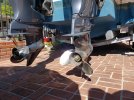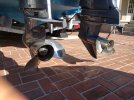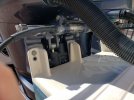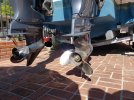- Joined
- May 6, 2009
- Messages
- 120
- Reaction score
- 25
- Points
- 28
- Location
- Los Angeles, CA
- Model
- Gulfstream
I was looking at the location of the cavitation plates on the (2) 200hp outboards on my Gulfstream. I am wondering where the cavitation plates should be relative to the hull. In other words, should the cavitation plates be above or below the hull when motors trimmed down. The outboards are 2019 200h Yamaha's set on the top bolt hole on the grady bracket. There is an option to lower the motor to the bottom bolt hole which looks like it would lower the motor about 2". Thanks in advance. Len










